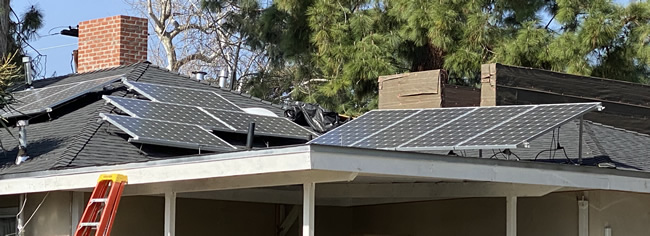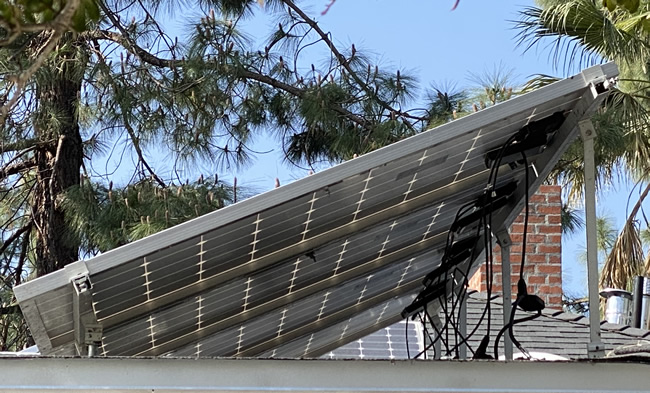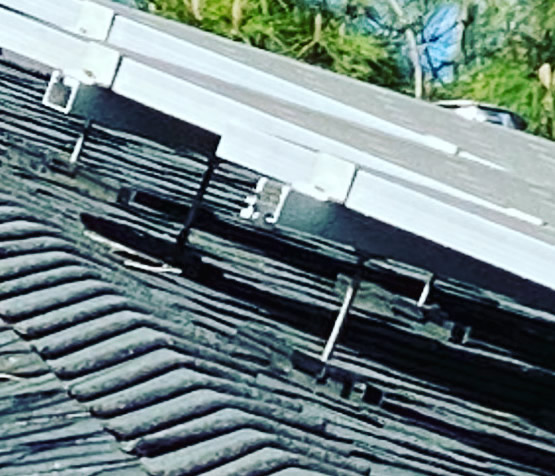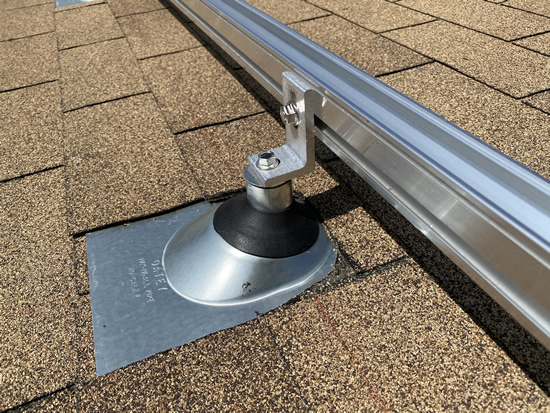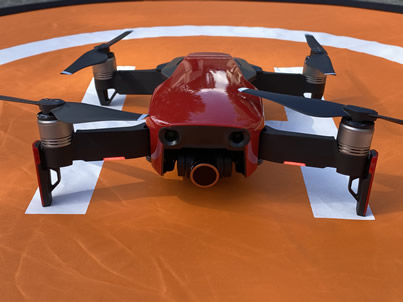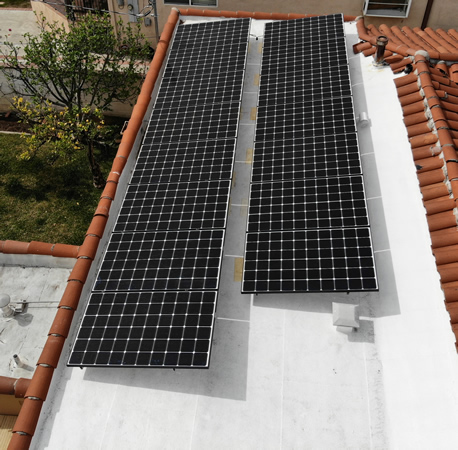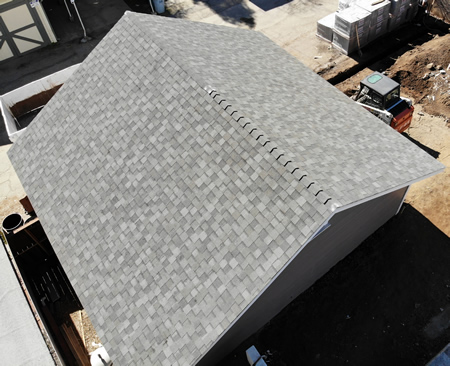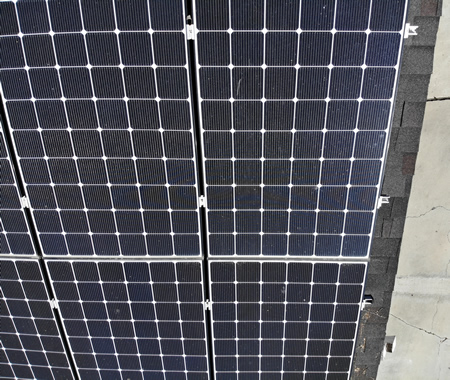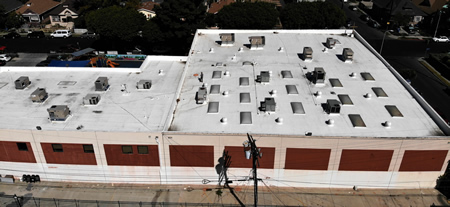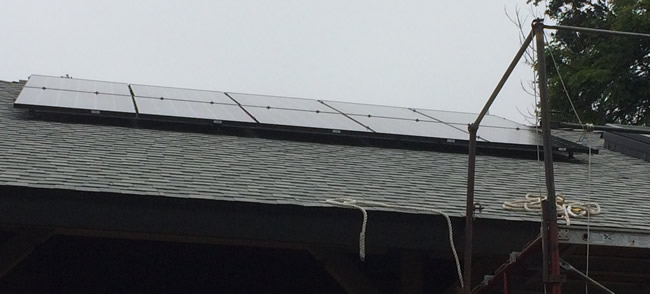Welcome to the
Run on Sun Monthly Newsletter

In this Issue: |
February, 2020
Volume: 11 Issue: 2
Watch Out - Shortcut Solar at Work!I suspect that most of my NABCEP-Certified colleagues have had this happen - you are on your way to a jobsite when you pass a solar installation that is so painfully bad, that it stops you in your tracks and you just have to go and take a closer look at what happens when Shortcut Solar has botched another job. Follow me into a realm where you never want to find yourself, the horrifying reality of Shortcut Solar at work!
Wow, there's a lot going on there and none of it good. The panels on the left are facing a variety of trees. The panels on the right have a significant pitch-up to the south, with a lot of exposure to the wind out of the north. The cable management there appears to be: let it just hang down. That middle section is supposed to have 18" of clearance at the hip given the panels on the adjacent face, but they are actually overlapping the hip! And how exactly are these attached to the roof? A closer investigation was in order!
Seriously? Looks like old Shortcut was in a real hurry the day they did this job! There is a rail there on the high end - surely you could have found some way to use that to get those cables in order - but clearly that wasn't a priority! But it was this last image that really got me going. Checkout this attachment scheme:
I apologize that the image isn't too clear, but let's try and break down what is going on here. At the base in the foreground you can see what appears to be a 3" or so piece of unistrut that has been cut to length and painted black. There is no flashing of any sort visible here. Instead, the strut has apparently been bolted directly onto the roof. Perhaps those clever fellows from Shortcut Solar drilled pilot holes and squirted in some sealant? Or maybe not - I mean why go to all that extra effort? So that's your attachment, now for the standoff - I know, how about a threaded piece of 3/8" steel? You can attach it at the bottom with a channel nut, and then just drill a hole in your aluminum rail and secure it with a nut above and below! What could possibly go wrong? Well let's start with the wind. When the Santa Ana winds blow out of the North, they will rock those panels, and that long, skinny bolt will flex with the wind. It is steel and the rail is aluminum, which means that the steel, over time, will chew into the aluminum. Enough flex over enough time, and that attachment scheme is going to fail - potentially in a catastrophic manner. (Wanna see what happens when steel defeats aluminum on a roof in the wind? Check this out!) It should come as no surprise that there is a better way to do this! Here's our preferred approach:
The picture above shows one of the strongest possible combination of solar attachment components you could ask for. The rail and L-foot comes from Everest. The 3-inch standoff is from Unirac and the flashing is from Oatey. Under the flashing is a rounded-rectangular base plate that accepts two, 5/16" x 3 1/2" lag bolts. Two lag bolts gives you twice the strength, and hedges against hitting just the side of a rafter, or a possibly rotted/weak spot. The 3-inch standoff screws down onto the base, and the Oatey flashing goes over it all, insuring that it will not leak. The L-foot is bolted to the standoff and is in turn bolted into the rail - which was engineered to accept this configuration. All components are torqued to the manufacturer's specification, and marked to indicate that the torquing was performed. Does it take longer to do things that way? To be sure. Does that mean it costs more to do it this way? Of course. But ask yourself, which of these approaches would you want on your roof? We take pride in doing things the right way for our clients so that they can sleep well at night, no matter how hard the wind blows! And we will continue to brake for Shortcut Solar and call out his subpar work whenever we see it so that you, a solar homeowner, will know what to look out for when you choose a solar installer! |
“…you are on your way to a jobsite when you pass a solar installation that is so painfully bad, that it stops you in your tracks and you just have to go and take a closer look…”
Get your copy of
Commercial Solar:
Step-by-Step
from
Run on Sun
Founder & CEO
Jim Jenal

Now available on Amazon.com
in both
Print & Kindle versions.
Commercial Solar:
Step-by-Step
from Run on Sun
Founder & CEO
Jim Jenal

Now available on Amazon.com
in both Print & Kindle versions.
Help Us Spread the News!


Run on Sun Enters the Drone Era!Just about a year ago, we really started thinking seriously about what drone technology might add to our solar installation company. The folks over at Scanifly -- with their ability to take drone images and convert it into a 3-D model of a potential solar site, without needing to climb onto a roof, was really appealing. And that got us thinking of other ways a drone might be helpful - as with finished project photography, or inspecting existing systems. All of that seemed possible, but certainly there were obstacles in the path. Well now, a year later, those obstacles have been surmounted, and Run on Sun has officially enter the Drone Era! Here's how we did it... ResearchWe started by doing some homework. Lots of it. Watching videos to see what it would take to make this happen. The list was fairly long: what drone to purchase (there are a lot of drones out there!), how do you learn to fly one (safely!), what does it take to do this legally? And on and on. Choosing a drone...Drones come in all shapes and sizes - to say nothing of costs. Last year LG sent out a professional crew to photograph one of our installations (you can see one of those photos here), and they used a $20,000 drone for the task. Clearly that was going to be too rich for our blood!
Making it LegalChoosing a drone was fairly easy. Figuring out how to fly it legally, that was more challenging. Way back in the day, I was a private pilot, but I found that I either had the time, but no money, or the money, but no time. And living in the greater LA area meant dealing with the most complicated airspace in the country, if not the world! So I quit flying when my daughter was born and haven't flown since. But, that did give me a leg up in learning how to fly legally, since I was generally familiar with the rules and regulations from the Federal Aviation Administration (FAA). One of the first things you learn is that any drone that weighs more than 0.55 pounds must be registered. Our Mavic Air weighs in at just over 15 ounces, so registration was a must. Turns out that is super easy, and can be done online for a nominal fee. We had our local label maker create registration labels so our Mavic Air is legal everytime it flies! Of course, getting me licensed was another matter! I found a number of great resources online, including this great video created by Tony Northrup! Tony's video is an hour and forty-three minutes long and I watched it multiple times. He is clear, funny, and amazingly helpful. I also found an online study guide (currently unavailable as they update it) here. The test consists of 60 multiple choice questions and you need a 70% to pass. While a significant number of the questions are really just common sense - like is the FAA going to ever suggest that having a drink of alcohol will improve your visual acuity??? - there are a number of questions that require you to parse a weather report that looks like this: KIAD 180005Z 19008KT 10SM TS SCT060CB BKN090 BKN200 31/21 A3002 RMK AO2 TSB04 FRQ LTGICCCCG SW TS SW MOV NE T03060211 (seriously!), or puzzle through a sectional chart that is one of the densest data presentations ever invented. (Don't believe me? You can download it here, but be patient, it will take a while!) Suffice it to say, I took my test prep seriously, and the result was rewarding: 100%! Now all I needed was to start flying! Flying for (fun) and Profit!So now that I was a fully licensed drone pilot, it was time to start putting those skills to use. Here are some recent drone shots and a description of their application. (In each case, clicking on the image will give you a full-scale picture. We really think that the drone brings us a new level of safety and competence. So when you call us for that site evaluation, don't be surprised if we never break out the ladder, but instead let Oscar - the newest member of the Run on Sun team - do the hard work for us! |
SMUD Scheme Threatens New Solar Homes MandateWith very little fanfare, the Sacramento Municipal Utility District ("SMUD") just convinced the California Energy Commission to allow it to offer a SMUD-owned alternative to installing solar power systems on new homes under California's just instituted New Solar Homes mandate. As other municipal utilities lined up in support -- including PWP, LADWP, BWP and GWP -- it is clear that this is nothing short of a full-on assault against the New Solar Homes mandate. Here's our take... The intent of the New Solar Homes mandate was to install appropriately sized solar power systems on every new home in California. There are many benefits to such a program, including providing distributed power across the grid, thereby increasing grid reliability, as well as generating jobs and raising public awareness as solar becomes commonplace.
The SMUD scheme thwarts all of that. Instead, a SMUD-owned solar farm would have it production allocated across participating new homes. (Tellingly, the SMUD scheme does not permit privately built community solar farms to participate in the program!) Worse yet, the SMUD scheme effectively prevents subsequent home owners from adding local solar, since the first 4,700 kWhs must come from the SMUD-owned facility. So how did this get approved? In addition to all of the municipal utilities in California lining up behind SMUD's power grab, so did much of the building industry (as they can simply fill out paperwork for compliance instead of actually building solar systems), and the IBEW (whose members get employed when utility-scale solar farms are built). On the short end of the stick are local solar contractors, and consumers who lose the power to choose their own, local solar system because the builder decided to opt-into SMUD's scheme. What say you, PWP?Which brings this back home. While Pasadena Water and Power did not submit their own letter of support (that we could find), their trade association, the California Municipal Utilities Association, did. Now there aren't that many new homes being built in Pasadena at this point, but can we expect to see a similar power grab from PWP? LADWP did submit their own letter and there are plenty of new homes going up within the City's boundaries - is a similar scheme in the works? The utilities rely on consumers being largely uninformed as to these schemes to push them through. We will be keeping an eye on what our local utilities bring forward in the coming months. Watch this space. |
